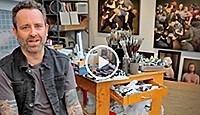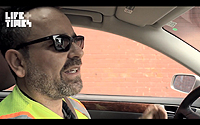![]()
Meet Dan Witz, Street Art Pioneer
By Andy Cush |
In the late 1970s, Dan Witz began painting hummingbirds on walls around downtown Manhattan. The work — created illegally, with acrylic paint and brushes — so predated any notion of “street art” that the term hadn’t even been codified yet. It was years before artists like Keith Haring would attract a mainstream audience to the format, and decades before the likes of Banksy and Shepard Fairey became household names.
Now, Witz is 56. He has a young son, and, soon, he’ll be married. Street art is an international phenomenon, with superstar artists regularly drawing top-dollar at auction. And he never stopped putting up work. “I just kept doing it because I like doing it so much,” he tells ANIMAL while driving to install a new piece along the Downtown Brooklyn waterfront. “On a nice day, on the weekend, I would just go out and do art, like someone else would go out and play tennis.”

(Photo: @Dan Witz)
It would be easy to pass one of Witz’s pieces on the street without noticing it. Lately, they’re designed to fit naturally into their surrounding landscapes, so that an image of an air vent or a barred-over window might initially be mistaken for the real thing. On closer inspection, however, shadowy figures are always lurking behind the industrial architecture: hands claw to escape; eyes gaze out sullenly; lovers kiss, unaware of or indifferent to their imprisonment. ”It’s very illusionistic. You’d walk right by, maybe 50 times, until you happened to look up and notice. ‘Oh, there’s a dude. Oh, it’s a piece of art,” Witz says.
The artist creates his works ahead of time in his Williamsburg home studio and places them around the city in broad daylight, wearing a bright yellow road worker’s jacket and hardhat. The installation process, which involves a hammer, nails, and a power drill, takes a little longer than Witz would like, but the conspicuous getup allows him to hide in plain sight while he works. Before leaving to install the Downtown Brooklyn piece, however, he had some doubts about his skinny jeans.
“Cops are a little too smart,” he said with a chuckle. “They scan and they see something a little weird, and then they know something’s up.” Over the years, Witz has run into the police while working more times than he can count, but he’s never been arrested — something he chalks up to a combination of his honesty about what he’s doing, the potentially complicated process cops would face in booking him, and, the possibility that some of them actually enjoy his work. The police, Witz says, are “basically art critics.” Graffiti writers, purely vandals in the law’s eyes, wouldn’t get the same treatment.

ABC No Rio 2011
Unlike some of his contemporaries, who are content to make a living selling paintings that simply place their street motifs on canvas, Witz maintains a studio practice that’s wholly independent from from his illegal output. For the past 15 years, he’s been making what he terms “academic realist paintings” of mosh pits at hardcore punk shows, depicting figures that writhe with all the virility and drama of Heironymous Bosch’s crowds — but instead of clamoring for a shot at Christ before the crucifixion, they’re pummeling each other to the music of Vision of Disorder or Agnostic Front. Witz’s solo show “NY Hardcore,” which runs April 5-May 3 at Jonathan Levine Gallery, showcases these paintings.
“I’m an academic realist painter, but I’m living in 2014, so I’m not going to be painting Roman soldiers invading, or some gothic baroque composition, like the rape of the Sabine women,” he says, referencing a Roman historical scene that was a popular subject for Renaissance painters. “The highest aspiration of an academic realist painter are these big group figure paintings, and I’m using the hardcore scene as my subject.”

(Photo: Aymann Ismail/ANIMALNewYork)
Witz is well-versed in music — in the 1980s, he spent time in a band backing the experimental guitarist and composer Glenn Branca, alongside such art-punk luminaries as Thurston Moore, Lee Ranaldo, and Michael Gira — but he considers himself an outsider to the hardcore scene. When he goes to concerts to take the photographs that eventually become his paintings, however, he feels welcomed. Despite the fact that he’s an “old guy” who’s there as a voyeur, he says, “there’s a strange, established etiquette of the pit, and somehow that includes helping me out. Maybe it helps that I have tattoos.”
If there’s a disconnect between Dan Witz the rebellious street artist, intent on giving away art for free, and Dan Witz the realist painter, exhibiting his works in a Chelsea gallery, that doesn’t give him any conflict. The money Witz makes from sales allows him to continue putting up street pieces, and each setting is suited to working through a particular set of ideas. Just like Rembrandt made etchings and paintings, Warhol made prints and films, and Degas made sculptures and pastels, Witz says, he works in the studio and out in public — in this case, on the side of the road near a construction site.
Ultimately, the Downtown Brooklyn piece goes up without a hitch. Aside from a security guard at the construction site, who watches Witz for a moment before walking away, no passersby even notice what he’s doing, and in minutes he’s back in the van, heading home to his family.
http://animalnewyork.com/2014/meet-dan-witz-street-art-pioneer/







